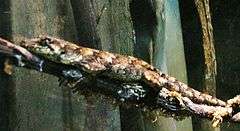Forest gecko
The forest gecko (Mokopirirakau granulatus) is a species of gecko. Granulatus refers to the granular texture of the skin.[2] Its Māori name is moko pirirākau ("lizard that clings to trees").[3][4] It is endemic to New Zealand, found in all areas except the Far North, Marlborough, and Canterbury.
| Forest gecko | |
|---|---|
 | |
| Scientific classification | |
| Kingdom: | Animalia |
| Phylum: | Chordata |
| Class: | Reptilia |
| Order: | Squamata |
| Family: | Diplodactylidae |
| Genus: | Mokopirirakau |
| Species: | M. granulatus |
| Binomial name | |
| Mokopirirakau granulatus Gray, 1845 | |
| Synonyms | |
| |
In June 2010 seven forest geckos, four female and three male, were stolen from a wildlife park in Northland.[5] Forest geckos are a protected species under the Wildlife Act 1953.
Conservation status
In 2012 the Department of Conservation reclassified the forest gecko as At Risk under the New Zealand Threat Classification System. It was judged as meeting the criteria for At Risk threat status as a result of it having a low to high ongoing or predicted decline. This gecko is also regarded as being Data Poor which indicates the Department of Conservations uncertainty about the listing due to lack of data.<ref name="Conservation 2012" /
See also
- Geckos of New Zealand
References
- Hitchmough, Rod; Anderson, Peter; Barr, Ben; Monks, Jo; Lettink, Marieke; Reardon, James; Tocher, Mandy; Whitaker, Tony. "Conservation status of New Zealand reptiles, 2012" (PDF). Department of Conservation. The Government of New Zealand. Retrieved 18 July 2015.
- Gill, B.J. and Whitaker, A.H. (2001). New Zealand Frogs and Reptiles. David Bateman Limited, Albany, Auckland, New Zealand
- "moko pirirākau - Māori Dictionary". maoridictionary.co.nz. Retrieved 2017-01-17.
- "Atlas species information - Mokopirirakau cryptozoicus". www.doc.govt.nz. New Zealand Department of Conservation. Retrieved 2017-01-17.
- Eriksen, Alanah May (30 June 2010). "Thousands for stolen geckos on European black market". New Zealand Herald. Retrieved 29 June 2010.
External links
| Wikimedia Commons has media related to Forest gecko. |
| Wikispecies has information related to Hoplodactylus granulatus |
- Hoplodactylus granulatus at the New Zealand Herpetological Society
- Hoplodactylus granulatus at the J. Craig Venter Institute
